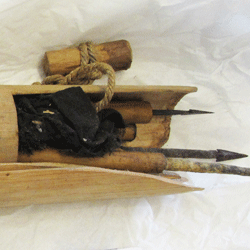PART.2
Testing of a sample of six stone-tipped pre-dynastic Egyptian arrows, dating from 4,000 years BC and conserved in the Phoebe A Hearst Museum of Berkeley (USA), is now taking place. At the time these arrows where first studied, 40 years ago, the researchers removed small portions of the black residue present on the tips, and injected into a cat. The reaction of the poor animal (which did survive) was evidence of the presence of a poison on the arrows.

Egyptian arrow with poison, copyright of Phoebe A Hearst Museum of Berkeley (USA)
“Nowadays we have the right instruments to get more information without cruelty to animals. Initial tests strongly suggest the presence of Acokanthera, a poisonous plant on our database, but we can’t be completely certain as there are a number of components in the compound,” said Borgia.

Poisoned arrows for crossbow, China, copyright of Museum of Archaeology and Anthropology, Cambridge
“It made good sense for people to use poisons. On their own, Palaeolithic weapons with stone arrowheads may not have been deadly enough to immobilise or kill a large animal such as a red deer. Poisons plants were plentiful and the Prehistoric population knew the environment where they lived, they knew the edible plants and their potential as medicines and poisons. To fabricate a poison is easy and economic, and the risk is minimal. In addition, the making of poisons is often part of the tradition and the rituality of hunting.”
When archaeologists remove items from the ground in the course of field work, they brush off the soil adhering to the finds and sometimes even wash objects. Borgia is appealing to fellow archaeologists to contact her when they find weapons and not to clean up their finds. “Now we have this technique available, and have shown that it works, we need to test it as much as possible on archaeological samples,” she says.

Pot of curare, Peru, copyright of Pitt Rivers Museum, University of Oxford.
Borgia denies that her family name (Lucrezia Borgia is legendary as a devious poisoner) prompted her interest in poisons but she delights in the Latin quip ‘nomen omen’. It translates roughly as ‘significant name’ and certainly the name Borgia has powerful historic resonances. Luckily for Borgia’s colleagues, her objectives are honourable and entirely academic.
She says: “Investigation of the use of poisons in Prehistoric periods adds to our understanding of hunting techniques and rituals, and also how the plant world was exploited. The Renaissance physician Paracelsus wrote that dosis facit venenum(the dose makes the poison). Ethnographic studies tell us that the most common toxic plants used in poisons were also used to treat diseases. Not surprisingly, the same substances are the basis for many medications still in use today.”